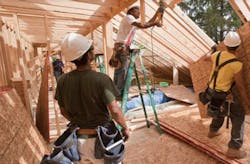Hard Costs: The Hard Truth
America has a housing affordability problem. I know it, you know it, and consumers certainly know it.
A complex issue with no silver bullet, the lack of housing for people at or below median household income in a given market is, at its core, straight out of philosopher Adam Smith’s bible of capitalist economic theory, The Wealth of Nations. “New housing supply is not keeping up with rising demand,” said Sam Khater, Freddie Mac’s chief economist, earlier this year. He cites a national shortage of 3.3 million homes, a figure he predicts will increase by 300,000 units this year. And Lawrence Yun, National Association of Realtors’ chief economist, adds: “New home construction needs to robustly ramp up ... to meet rising housing demand.”
Easy to say, far harder to do—or we’d be doing it, right?
Given the current demand for homes among those with ample means, that trigger remains as elusive as homeownership for a growing number of consumers.
Certainly, you can make the argument that lack of land is the biggest barrier to building more homes—the No. 1 challenge cited by this year’s Housing Giants. Increasingly worrisome are government regulations, namely withholding land via growth boundaries and imposing fees that builders must cover with higher prices to sustain an average (and relatively meager) 7.6% net profit.
All that’s true, but finished-lot costs and profit add up to less than 30% of a new home’s price, according to National Association of Home Builders’ research, while hard costs—labor and materials, from footings to finishes—make up more than 60%. So it seems like fertile ground to knock down that line item to better enable lower housing prices and enlarge the buying pool. Again, easier said than done.
Off-site construction is an obvious option, but legacy labor and supply-chain infrastructures, as well as old-school mindsets, must shift dramatically for it to have an impact. Multifamily’s economies of scale are similarly attractive, unless COVID-19 sucks the air out of higher densities. And don’t forget waste, which studies (and our own columnist Scott Sedam) repeatedly cite as somewhere between 10% to 20% of hard costs. Like off-site, wringing waste from processes requires a cultural shift most builders seem unwilling or unable to make.
Kit homes, tiny homes, accessory dwelling units, and the like all have their place in the market, but they still cost more per square foot than the average new home. One kit home company promising to “help Americans build their dream home at a fraction of the cost” offers a 1,119-square-foot, two-bedroom/one-bath home with a roughed-in basement for $147 per square foot, nearly twice what it costs for the same scope of work to build the average 2,464-square-foot detached new home.
The answer will only surface when you’re truly motivated. Given the current demand for homes among those with ample means, that trigger remains as elusive as homeownership for a growing number of consumers.
Stay Connected to Pro Builder
-
Watch The Weekly every Thursday at noon ET, featuring a trio of expert industry insights
-
Follow us on Facebook to see exclusive and expanded content from the 2020 Aurora Awards and The Weekly
Access a PDF of this article in Pro Builder's July/August 2020 digital edition

